In today’s world, sustainable living is becoming more critical than ever. As a result, I am always on the lookout for ways to make my life more eco-friendly. One area that can have a significant impact on our planet is energy-efficient lighting.
By using green lighting solutions, we can reduce our carbon footprint and conserve energy for a brighter future. In this article, I’ll explore some of the latest trends and technologies in energy-efficient lighting solutions, as well as tips for incorporating them into your home or business. So, let’s dive in and start creating a more sustainable living space!
Key Takeaways
- Energy-efficient lighting plays a crucial role in promoting sustainable living and reducing environmental degradation.
- LED technology and solar-powered systems offer reduced carbon footprint, enhanced efficiency, longevity, and aesthetics.
- Smart lighting systems provide automated control and intelligent adjustments for improved energy efficiency and convenience.
- Natural lighting design techniques, such as daylight harvesting and skylights, can reduce energy consumption and enhance building aesthetics.
- Solar-powered lighting solutions are a sustainable choice for both outdoor and indoor applications.
- Bioluminescent lighting holds promise for renewable, non-electrical, and low-environmental-impact illumination in the future.
- Photocell sensors and dimmer switches can help conserve energy by customizing lighting intensity based on external factors and personal preferences.
The Environmental Impact of Traditional Lighting
Traditional lighting sources, primarily incandescent bulbs, are notorious for their excessive energy consumption and detrimental impact on the environment. A staggering 90-95% of the energy consumed by these bulbs is lost as heat instead of light, contributing to substantial energy wastage.
Lightology highlights the importance of keeping light fixtures and bulbs clean. Dust and particulates can reduce the efficiency of bulbs, so wiping them with a soft, dry cloth can maintain their efficiency and original luminosity.
Furthermore, compact fluorescent bulbs (CFLs), while more energy-efficient than incandescents, contain mercury, posing additional environmental risks. Improper disposal of these CFLs can result in hazardous mercury content seeping into the surroundings, leading to soil and water contamination that can be detrimental to both animals and humans. Transitioning to more sustainable lighting options can significantly reduce the traditional lighting environmental impact.
“Around 90-95% of the energy consumed by traditional incandescent bulbs is lost as heat instead of light.”
Understanding the energy consumption of different lighting sources can help us make informed decisions regarding lighting choices in our homes and workplaces. The table below shows the comparison of various lighting technologies based on energy consumption and lifespan:
| Lighting Technology | Average Lifespan (Hours) | Energy Consumption (Watts) |
|---|---|---|
| Incandescent Bulbs | 1,000 | 60 |
| Compact Fluorescent Bulbs (CFLs) | 10,000 | 14 |
| LEDs (Light Emitting Diodes) | 50,000 | 10 |
By moving away from energy-intensive incandescent bulbs and careful disposal of CFLs, we can pave the way for a more sustainable future. Embracing energy-efficient alternatives such as LED lighting, which consumes less electricity and promotes longer-lasting illumination, is a crucial step in reducing the environmental footprint caused by traditional lighting sources.
- Switch to energy-efficient lighting options like LEDs.
- Properly dispose of CFLs to prevent mercury contamination.
- Consider using smart lighting systems and sensors to minimize energy wastage.
As responsible individuals, we have the power to make eco-friendly choices that benefit both the environment and ourselves. By choosing sustainable lighting solutions, we can significantly reduce energy consumption and mitigate the environmental impact of traditional lighting.
Eco-conscious Lighting Choices: Trends and Tech
In recent years, several sustainable lighting options have emerged, transforming the way we illuminate our living and working spaces. This section will explore the rise of LED light bulbs, smart lighting systems, and energy-saving options incorporated with timers and sensors.
The Rise of LED Light Bulbs
LED light bulbs have become a popular choice in eco-conscious trends due to their energy-efficient lighting and long-lasting illumination. Boasting a lifespan of nearly 100,000 hours, LED technology consumes up to 80-90% less energy compared to traditional bulbs. This reduces electricity consumption and eliminates the use of harmful chemicals like mercury found in compact fluorescent lamps.
Advancements in Smart Lighting Systems
Smart lighting systems represent a significant leap in eco-friendly lighting by providing homeowners and businesses with intelligent lighting control. These automated lighting solutions allow users to adjust lighting levels, color temperatures, and operation times easily, enhancing convenience and optimizing electricity usage. With energy-saving technology, smart lighting systems contribute to a reduced environmental footprint for a greener future.
Energy-saving Lighting Options with Timers and Sensors
Efficient lighting solutions, such as those equipped with timers and sensors, provide a dynamic approach to energy conservation. Devices like occupancy and motion sensors detect the presence or absence of individuals and adjust lighting accordingly, minimizing electricity usage when not needed. Additionally, by programming lighting timers to switch lights on or off at predetermined times, users can further contribute to energy savings and eco-efficiency.
Investing in LED light bulbs, smart lighting systems, and energy-saving options with timers and sensors will not only save you money in the long run, but also aid in the global effort to embrace environmentally responsible practices.
To summarize, adopting LED light bulbs, smart lighting systems, and energy-saving options featuring timers and sensors is an excellent way to contribute to eco-conscious trends and benefit both your wallet and the environment. So, consider these innovative solutions to minimize your energy consumption as you light up your spaces.
Natural Lighting Design and Its Benefits
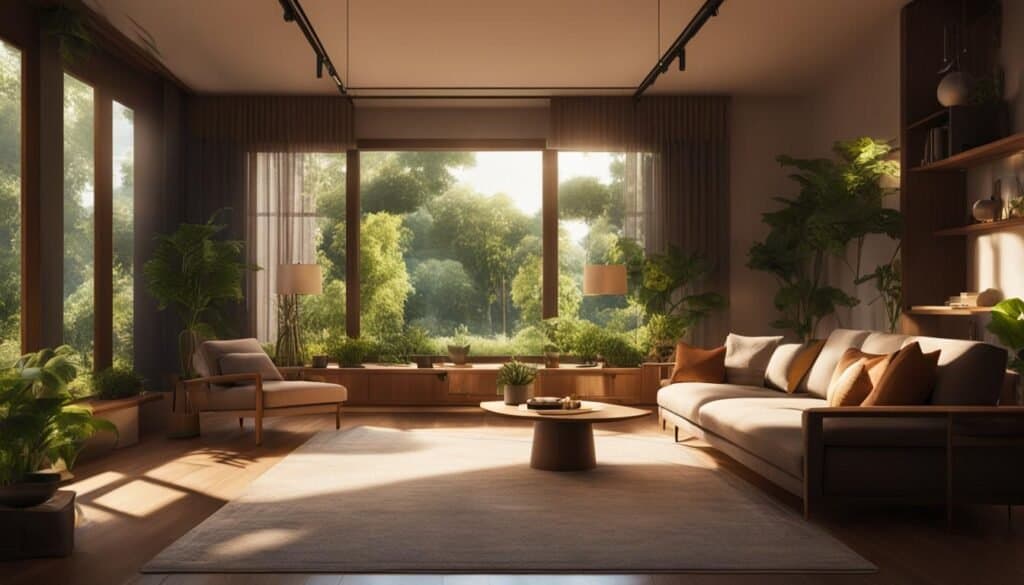
Natural lighting design plays a crucial role in sustainable architecture by reducing the reliance on artificial lighting and subsequently, energy consumption. Harnessing daylight can lead to energy savings of up to 75%, making it an eco-friendly solution that aligns with sustainable principles and promotes human well-being. Moreover, incorporating natural light into architectural designs can assist in achieving LEED certification for green buildings.
- Daylight harvesting
- Skylights
- Light shelves
- Light pipes
These various techniques contribute to a building’s energy efficiency, enhance aesthetic appeal, and offer substantial benefits to occupants. Let’s delve deeper into each of these methods:
Daylight Harvesting
Daylight harvesting is a popular technology that maximizes the use of natural light in indoor environments, adjusting artificial lighting levels based on the ambient daylight. This sustainable approach can significantly reduce energy consumption and improve occupants’ overall well-being, as natural light is known to boost mood and productivity. Furthermore, it offers an aesthetically pleasing aura by creating a visually stimulating and comfortable ambiance.
Skylights
Skylights act as a window to the sky, offering direct access to sunlight and promoting natural ventilation. These architectural elements can transform a space by introducing a clean, bright, and spacious atmosphere. Moreover, their strategic placement can enhance a room’s interior design, making it visually appealing and energy-efficient.
Light Shelves
Light shelves are horizontal elements installed on the exterior or interior of a building, designed to reflect sunlight onto ceilings and distribute light across a room. They serve as both functional and decorative features, ensuring an even distribution of natural light and creating a more comfortable and sustainable space.
Light Pipes
Light pipes, also known as sun tunnels or solar tubes, are designed to channel sunlight from the exterior to the interior of a building. They utilize highly reflective materials to transfer light through space, making them a valuable addition to spaces with limited access to windows or skylights. By providing a natural and bright ambiance, light pipes contribute to energy efficiency and a healthy indoor environment.
“Incorporating natural lighting design into architecture helps reduce energy consumption while enhancing the aesthetic appeal of a space.”
Natural lighting design techniques such as daylight harvesting, skylights, light shelves, and light pipes have the potential to make a significant impact on sustainable architecture. By harnessing daylight, these methods encourage energy-efficient practices and create aesthetically pleasing, well-lit environments that promote both human well-being and environmental sustainability.
Embrace the Power of Solar: Outdoor and Indoor Lighting Solutions
Embracing solar power for both outdoor and indoor lighting solutions presents numerous advantages, including energy efficiency and cost savings. Solar lighting systems, using photovoltaic panels, convert sunlight into electricity, eliminating the need for grid-supplied power.
EcoMastery Project emphasizes the importance of using dimmers and timers for energy efficiency. Dimmers allow for adjusting the brightness of lights to save energy, while timers can reduce electricity usage by ensuring lights are only on when needed.
Installation flexibility, minimal maintenance, and zero harmful emissions characterize these environmentally friendly systems. With the added benefit of scalability, solar-powered lighting solutions are a sustainable choice for various applications such as street lighting, garden decor, and security lighting.
Renewable energy is the future of sustainable living with solar-powered lighting solutions leading the way.
One of the most popular types of solar-powered outdoor lighting is solar-powered security lights. These lights offer increased safety as they automatically illuminate when motion is detected, providing homeowners with a sense of security while conserving energy.
- Street lighting: Solar street lights offer an eco-friendly alternative to traditional street lighting, reducing the consumption of energy and lowering carbon emissions.
- Garden decor: Solar-powered garden lights add both aesthetic value and functional illumination to outdoor spaces without relying on conventional power sources.
- Security lighting: Solar-powered security lights allow homeowners and businesses to maintain a well-lit property, deterring potential intruders and enhancing safety.
In addition to outdoor applications, solar power has the potential to revolutionize sustainable indoor lighting as well. By integrating solar panels into the design of windows or skylights, homeowners can harness the power of the sun to light their homes during daylight hours, decreasing the need for artificial lighting and reducing electricity consumption.
| Application | Advantages |
|---|---|
| Outdoor Lighting | Energy-efficient, cost-effective, versatile, and environmentally friendly |
| Indoor Lighting | Potential to harness natural sunlight, reducing reliance on artificial lighting and electricity use |
As the importance of renewable energy continues to grow, it is essential for homeowners and businesses to consider solar-powered lighting solutions. These environmentally friendly technologies not only reduce energy consumption and operating costs but also contribute to a sustainable and efficient lifestyle.
Bioluminescent Lighting: The Future of Sustainable Illumination
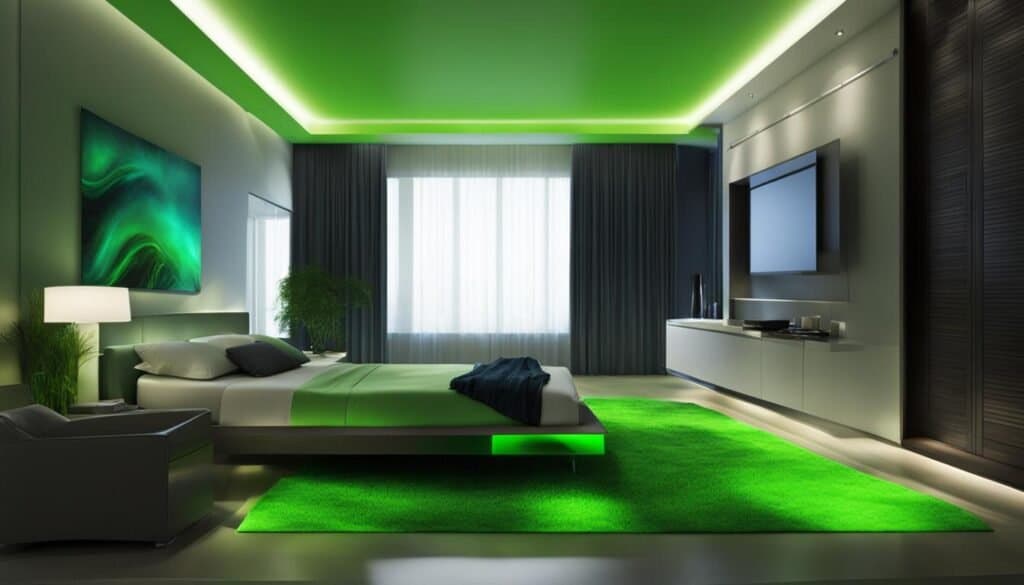
Bioluminescent lighting is an innovative approach to sustainable illumination that harnesses the power of nature to create eco-friendly light sources. This method of lighting is based on the natural process of bioluminescence, where certain organisms emit light through complex chemical reactions. Scientists and researchers are continually exploring ways to harness bioluminescence for a wide range of future lighting applications, potentially providing renewable, non-electrical, and low-environmental-impact solutions.
Bioluminescent lighting holds great promise as a renewable, visually appealing, and extremely low-impact light source.
There are several reasons why bioluminescent lighting has become increasingly popular as a sustainable illumination method:
- It is a renewable light source, reducing the demand for electricity generated from non-renewable resources.
- It is a naturally occurring phenomenon, meaning that it provides an eco-friendly alternative to traditional lighting methods.
- It can be visually appealing, with the potential to produce various colors and intensities to suit different applications and settings.
- It does not depend on electrical systems, offering a potential solution for off-grid or remote areas where access to electricity is limited or nonexistent.
| Bioluminescent Lighting | Traditional Lighting |
|---|---|
| Renewable and eco-friendly | Depends on non-renewable resources or eco-unfriendly materials |
| Natural light sources | Artificial light sources |
| Visually appealing and customizable | May not offer the same range of colors and intensities |
| Non-electrical, suitable for off-grid locations | Requires a connection to electrical grid or power supply |
While there are many potential applications for bioluminescent lighting, several challenges need to be addressed before widespread implementation can occur. These challenges range from the efficient harnessing of bioluminescent organisms to the development of sustainable storage and distribution systems.
As research on bioluminescent lighting continues to advance, this exciting technology could soon play a significant role in shaping the future of sustainable illumination and reveal exciting new opportunities for eco-friendly light sources in our everyday lives.
Integration of Motion Sensor Lighting for Efficiency and Security
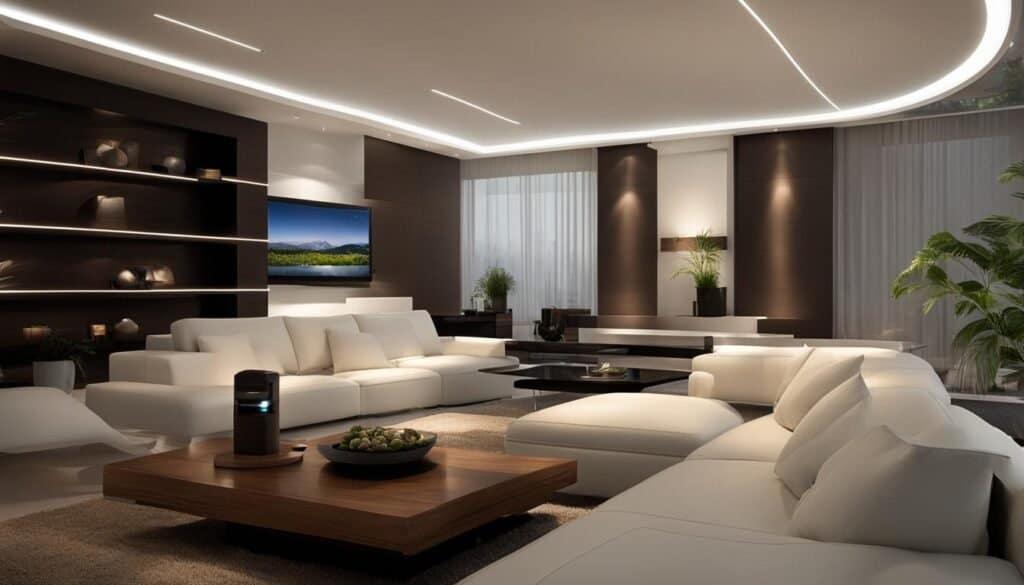
Motion sensor lighting has emerged as an essential component of energy conservation strategies and home security systems. By integrating motion sensors into residential and commercial spaces, users can enhance the energy efficiency of their lighting systems while simultaneously boosting their home’s security.
Save energy and improve home security with motion sensor lighting technology.
Detecting Movement to Save Energy
Intelligent lighting systems featuring motion-detection capabilities can dramatically reduce unnecessary power consumption and contribute to overall energy management. These sensors detect movement within specific areas and automatically adjust lighting conditions to provide practical energy savings. By ensuring that lights are only in use when necessary, motion sensor lighting contributes to environmentally responsible and cost-effective practices.
Enhancing Home Security with Automated Lighting
Motion-activated lights also play a crucial role in bolstering home security, as they serve as effective deterrents to potential intruders. By creating the appearance of occupancy, these smart home technologies offer security benefits that extend beyond energy savings. Homeowners can enjoy increased peace of mind by ensuring that their properties are well-lit in response to detected movement, thereby eliminating dark spots that could serve as hiding spots for unauthorized individuals.
- Smart home technology integrates motion sensor lighting with other intelligent systems such as security cameras and smart locks.
- Combine motion-activated lights with solar-powered options to maximize energy efficiency.
Investing in motion sensor lighting solutions not only promotes energy conservation and cost savings, but also enhances home security features, contributing to a safer and more sustainable living environment.
Energy-efficient Ceiling Fans with Lighting
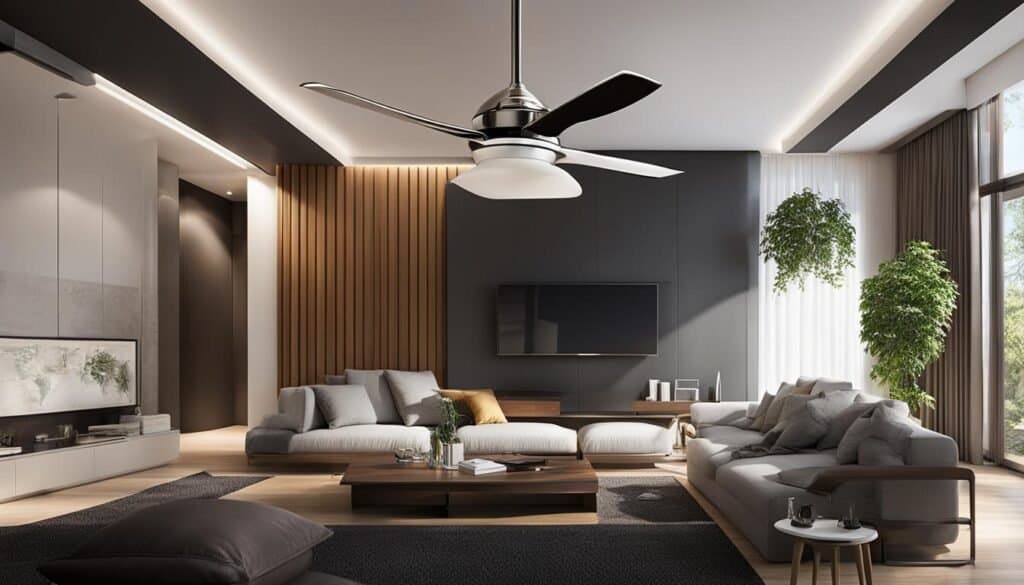
Energy-efficient ceiling fans with integrated lighting serve as a versatile and functional addition to eco-conscious homes. They provide improved air circulation, reducing heating and cooling needs, while also serving as an energy-saving lighting alternative. Offering both aesthetic and practical value, these green home accessories represent an increasingly popular choice for individuals seeking to enhance their home’s energy efficiency.
Combining stylish designs with energy conservation, these eco-friendly fans provide a range of options to suit every taste and preference. In addition to saving energy, they can also reduce your electricity bills and contribute to a more sustainable lifestyle. Let’s look at some of the key factors to consider when selecting an energy-efficient ceiling fan with lighting.
Energy-efficient ceiling fans can significantly cut down on your energy consumption, benefiting both your wallet and the environment.
Motor Efficiency: The motor is the heart of any ceiling fan, and it plays a crucial role in determining the fan’s overall energy efficiency. Opt for a fan with a high-quality motor that ensures maximum airflow with minimal power consumption.
LED Lighting: Choose a ceiling fan that features integrated LED lights, which are known for their energy efficiency and long-lasting performance. LEDs can consume up to 80% less energy compared to traditional lighting options such as incandescent bulbs.
Size and Features: Select a fan of the appropriate size and with the desired features for your room. Larger fans with higher airflow can reduce the need for air conditioning, while fans with reversible functions can help circulate warm air during the colder months.
- Motor Efficiency
- LED Lighting
- Size and Features
When deciding on the perfect energy-efficient ceiling fan with lighting for your home, consider your individual needs, preferences, and budget. Explore the extensive range of options available on the market, invest in an option that best aligns with your values and goals, and reap the benefits of both style and energy conservation.
To further illustrate the benefits of these combined solutions, let’s take a look at some popular energy-efficient ceiling fan options available today.
| Model | Motor Efficiency | LED Lighting | Additional Features |
|---|---|---|---|
| Hunter Dempsey Low Profile | WhisperWind motor | Integrated LED kit | Reversible motor, remote control |
| Emerson Curva Sky | Energy Star motor | Integrated LED kit | Wet location safe, remote control |
| Fanimation Odyn | DC motor | Dimmable LED light | Reversible motor, energy-saving mode |
In conclusion, energy-efficient ceiling fans with lighting offer a stylish and functional green home accessory that can help you save energy and reduce your carbon footprint. Embrace these combined lighting solutions to create a comfortable and eco-friendly living space, while contributing to energy conservation and sustainable living practices.
Lighting Up Your Garden: Solar-powered Street Lights and Decor
Illuminate your outdoor spaces using a sustainable and eco-friendly approach by installing solar-powered street lights and decorative elements in your garden. These systems harness solar energy throughout the day and provide efficient lighting at night, delivering cost-effective illumination without depending on the electrical grid. By incorporating energy-saving solar-powered solutions into your landscape design, you can enhance your garden’s aesthetics while minimizing energy consumption.
Available in various styles, solar-powered garden lights offer an attractive and responsible choice for elevating the beauty of your garden. They also contribute to the creation of an eco-friendly outdoor decor, encouraging sustainable garden lighting practices.
With solar-powered outdoor lighting options, you can make your garden illuminate brighter without leaving a negative impact on the environment.
- Solar-powered street lights
- Solar-charged decorative lanterns
- LED solar deck lights
- Color-changing solar-powered hanging lights
- Solar post lights for pathways
Below is a detailed comparison of popular solar-powered outdoor lighting options:
| Products | Primary Features | Styles |
|---|---|---|
| Solar-powered street lights | Used for illuminating driveways, streets, and pathways for increased safety | Classic lamp posts, modern lights with integrated panels |
| LED solar deck lights | Enhances the appearance of your deck and provides additional safety | Step lights, rail lights, post cap lights |
| Color-changing solar-powered hanging lights | Used to add a touch of color and whimsy to your garden | Spherical, crackle glass, mosaic designs |
| Solar post lights | Illuminate pathways to increase navigation and safety | Traditional, contemporary, rustic designs |
Choose a solar-powered lighting solution that complements your preferences and outdoor décor. Embrace sustainable garden lighting while reducing energy use and enjoy a captivating, eco-conscious, and illuminated garden.
Photocell Sensors and Dimmer Switches: Customizing Light Intensity
Creating a sustainable living environment relies heavily on energy-saving technology and eco-friendly home systems. Two essential components for sustainable lighting systems are photocell sensors and dimmer switches, both of which are instrumental in conserving electricity and reducing overall energy consumption.
How Photocell Sensors Contribute to Energy Savings
Photocell sensors have emerged as a popular energy-saving technology, playing a significant role in automated lighting adjustments. These sensors detect natural light levels and adjust artificial lighting accordingly, automatically turning lights off during daytime or when enough ambient light is available. As a result, this sustainable lighting control can considerably reduce electricity consumption.
Typically used in street lighting and outdoor fixtures, photocell sensors ensure optimal lighting conditions while maximizing energy efficiency. The integration of these sensors into lighting systems guarantees a more eco-conscious approach to sustainable living.
The Role of Dimmer Switches in Sustainable Living
Similar to photocell sensors, dimmer switches contribute to sustainable living by offering a customizable lighting experience. These switches enable users to control the intensity of light according to their needs and preferences, thereby conserving energy in the process.
By allowing users to adjust lighting levels and tailor the brightness to suit their requirements, households can significantly reduce energy usage. This energy reduction not only lowers electricity bills, but it also promotes a more personalized and eco-friendly lighting experience.
Incorporating dimmer switches into lighting systems is an accessible way to adapt to a sustainable lifestyle while reaping the benefits of stylish, customizable lighting options that align with various energy preferences.
“Using photocell sensors and dimmer switches in our homes and offices has substantially reduced our energy consumption, helping us make more conscientious choices towards a sustainable living environment.”
- Install photocell sensors in outdoor fixtures for efficient energy usage.
- Invest in dimmer switches to adjust the intensity of indoor light sources.
- Integrate sustainable lighting controls into your smart home system for a fully automated experience.
By implementing these energy-saving measures and embracing eco-friendly home technology, individuals can contribute to a greener future, making responsible choices in their day-to-day lives that will positively impact the environment in the long run.
Conclusion: Embracing Sustainable Lighting Practices
As we strive for a greener future, it is essential to adopt sustainable lighting practices and make conscious energy use decisions. Embracing innovative solutions such as LED technology, smart lighting systems, and solar power allows us to minimize our environmental impact while enjoying the benefits of highly efficient illumination.
By integrating future lighting technologies like bioluminescent lighting and energy-saving solutions such as motion sensors, photocells, or dimmer switches, we can further optimize our energy consumption and contribute to a more sustainable lifestyle. Making these green lifestyle choices not only has environmental benefits but also enhances our well-being by creating functional, comfortable, and aesthetically pleasing spaces.
Overall, investing in eco-friendly lighting solutions is a responsible, forward-thinking approach that aligns with the growing momentum toward sustainable living. Taking these steps today will help ensure a brighter and more environmentally-friendly future for ourselves and upcoming generations.
FAQ
What makes LED light bulbs an eco-friendly lighting solution?
LED light bulbs consume up to 80-90% less energy than traditional bulbs, have a lifespan that can last around 100,000 hours, and do not contain harmful chemicals like mercury. This makes them an ideal eco-friendly lighting solution for sustainable living.
How do smart lighting systems contribute to energy conservation?
Smart lighting systems provide users with the ability to control lighting through automated systems and intelligent controls, improving energy efficiency by allowing users to easily adjust lighting levels, color temperatures, and operation times to optimize electricity use.
What are the benefits of natural lighting design?
Natural lighting design harnesses daylight to reduce the reliance on artificial lighting, leading to energy savings of up to 75%. Techniques such as daylight harvesting, skylights, and light shelves contribute to a building’s energy efficiency and aesthetic appeal, promoting human well-being and sustainable architecture.
What are the advantages of solar-powered lighting?
Solar-powered lighting systems use photovoltaic panels to convert sunlight into electricity, eliminating the need for grid-supplied power. They offer installation flexibility, minimal maintenance, and zero harmful emissions, making them a sustainable choice for applications like street lighting, garden decor, and security lighting.
How do motion sensor lights save energy and enhance security?
Motion sensor lights detect movement within specific areas and automatically adjust lighting accordingly, providing practical energy savings by ensuring that lights are only in use when necessary. They also enhance home security by illuminating properties in response to detected movement, preventing dark areas that could serve as hiding spots for intruders.
What is the purpose of photocell sensors in sustainable lighting?
Photocell sensors detect natural light and can turn artificial lighting off during the day or when sufficient ambient light is present, efficiently conserving electricity. They are used in street lighting and outdoor fixtures to maximize energy efficiency while maintaining ideal lighting conditions.
How do dimmer switches help achieve sustainable living?
Dimmer switches allow users to adjust light intensity to match specific needs, reducing energy consumption. By utilizing just the right amount of light required, households can benefit from energy reduction and a more personalized, eco-friendly lighting experience.

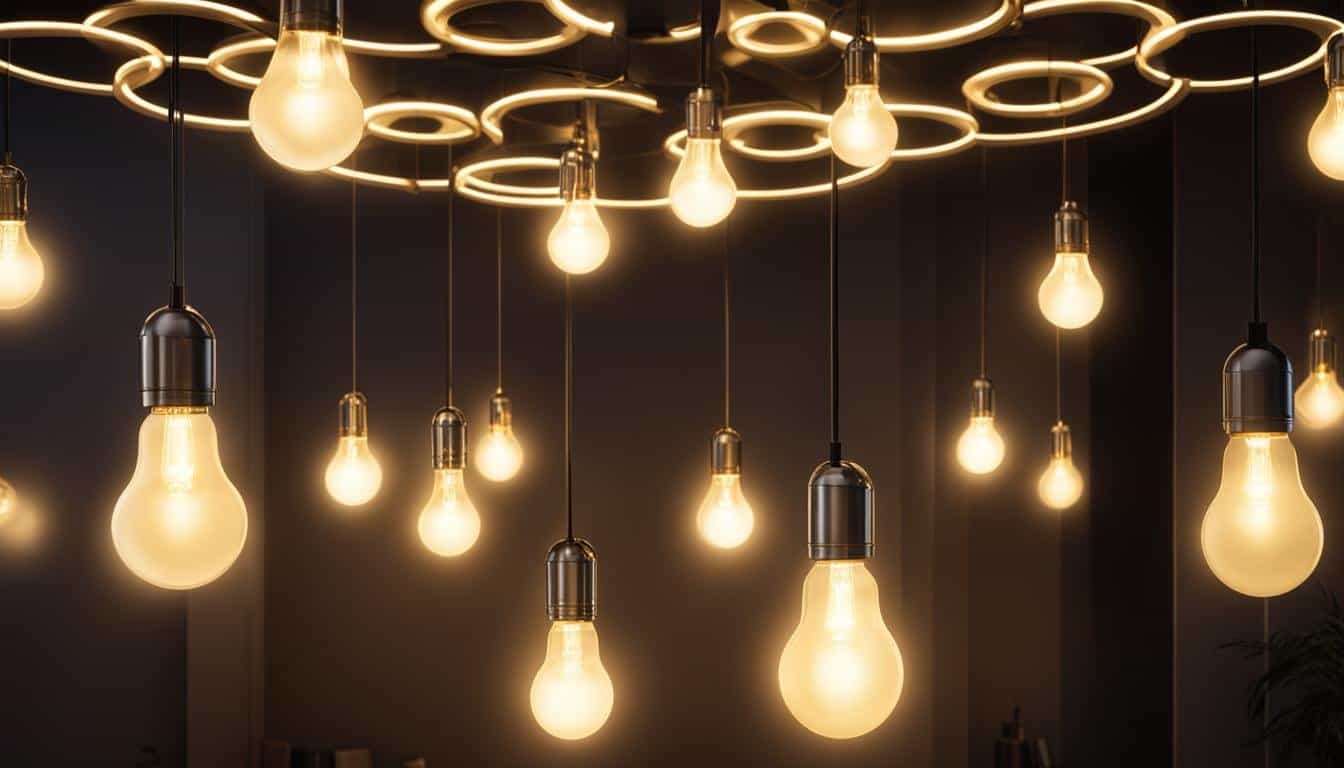



Leave a Reply